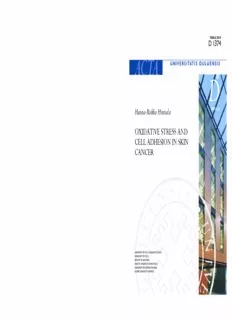
Oxidative stress and cell adhesion in skin cancer PDF
Preview Oxidative stress and cell adhesion in skin cancer
D OULU 2016 D 1374 1 3 7 4 UNIVERSITY OF OULU P.O. Box 8000 FI-90014 UNIVERSITY OF OULU FINLAND ACTA A UNIVERSITATIS OULUENSIS A C T A U N I V E R S I T A T I S O U L U E N S I S C T A D MEDICA Hanna-Riikka Hintsala Professor Esa Hohtola H OXIDATIVE STRESS AND a n n a CELL ADHESION IN SKIN University Lecturer Santeri Palviainen -R i ik CANCER k a Postdoctoral research fellow Sanna Taskila H i n t s a Professor Olli Vuolteenaho la University Lecturer Veli-Matti Ulvinen Director Sinikka Eskelinen Professor Jari Juga University Lecturer Anu Soikkeli Professor Olli Vuolteenaho UNIVERSITY OF OULU GRADUATE SCHOOL; UNIVERSITY OF OULU, FACULTY OF MEDICINE; Publications Editor Kirsti Nurkkala MEDICAL RESEARCH CENTER OULU; UNIVERSITY OF EASTERN FINLAND; ISBN 978-952-62-1268-5 (Paperback) KUOPIO UNIVERSITY HOSPITAL ISBN 978-952-62-1269-2 (PDF) ISSN 0355-3221 (Print) ISSN 1796-2234 (Online) ACTA UNIVERSITATIS OULUENSIS D Medica 1374 HANNA-RIIKKA HINTSALA OXIDATIVE STRESS AND CELL ADHESION IN SKIN CANCER Academic dissertation to be presented with the assent of the Doctoral Training Committee of Health and Biosciences of the University of Oulu for public defence in Auditorium F202 of the Faculty of Medicine (Aapistie 5 B), on 12 August 2016, at 12 noon UNIVERSITY OF OULU, OULU 2016 Copyright © 2016 Acta Univ. Oul. D 1374, 2016 Supervised by Docent Peeter Karihtala Docent Kirsi-Maria Haapasaari Professor Ylermi Soini Reviewed by Docent Susanna Virolainen Docent Pia Vihinen Opponent Professor Veli-Matti Kähäri ISBN 978-952-62-1268-5 (Paperback) ISBN 978-952-62-1269-2 (PDF) ISSN 0355-3221 (Printed) ISSN 1796-2234 (Online) Cover Design Raimo Ahonen JUVENES PRINT TAMPERE 2016 Hintsala, Hanna-Riikka, Oxidative stress and cell adhesion in skin cancer. University of Oulu Graduate School; University of Oulu, Faculty of Medicine; Medical Research Center Oulu; University of Eastern Finland; Kuopio University Hospital Acta Univ. Oul. D 1374, 2016 University of Oulu, P.O. Box 8000, FI-90014 University of Oulu, Finland Abstract Skin is the largest organ in our body protecting us from ultraviolet radiation and xenobiotics. UV- radiation is a common cause of squamocellular carcinoma and melanoma of the skin that cause morbidity and mortality world wide. Reactive oxygen species are constantly formed by, for example, cellular respiration and UV-radiation, and they can readily react with virtually any macromolecule within cell structures causing damage to DNA, proteins and lipids. Oxidative stress (OS) is a homeostatic process that is dysregulated in cancer cells to their benefit. Nuclear factor erythroid-2-related factor 2 (Nrf2) is the main regulator of antioxidant response and it has been shown to be upregulated in various cancers enabling their survival and growth. By using immunohistochemistry we studied the change and prognostic significance of OS markers in melanoma from paraffin embedded patient samples. Nrf2 expression is increased in melanoma, associating with deeper invasion and a worse melanoma-specific outcome. In addition, epithelial-to-mesenchymal transition markers Slug, Twist and Zeb1 showed altered expression levels in relation to invasion and metastasis associating also with Nrf2. With the help of target inhibition molecules Vemurafenib and MEK-inhibitor CI-1040, In vitro study showed that BRAF- and NRAS-mutations might activate Nrf2. Furthermore, Nrf2-regulated antioxidant enzyme peroxiredoxin I showed decreased expression in malignant melanomas and metastases compared to benign naevi. Intriguing findings were made from the surrounding structures of melanomas e.g. loss of expression of an oxidative lesion marker 8-hydroxy-2’-deoxyguanosine in adjacent endothelial cells associated with worse melanoma-specific survival. Changes in the expression of adhesion molecules claudins 1-5 and 7 were studied in the progression of cutaneous squamous cell carcinomas and preneoplastic lesions. Change in claudin composition can alter epidermal permeability and cell polarity. Efficiency of oncological treatment modalities is frequently based on oxidative stress damage. Nrf2-inhibition could offer the means to increase the sensitivity of cancerous tissue to oxidative insults and hinder proliferative and survival signalling. Later research should focus on the relation of Nrf2 with other signalling and observations made from the tumour microenvironment. Keywords: antioxidant enzymes, claudins, melanoma, Nrf2, oxidative stress, reactive oxygen species Hintsala, Hanna-Riikka, Oksidatiivinen stressi ja soluadheesio ihosyövässä. Oulun yliopiston tutkijakoulu; Oulun yliopisto, Lääketieteellinen tiedekunta; Medical Research Center Oulu; Itä-Suomen yliopisto; Kuopion yliopistollinen sairaala Acta Univ. Oul. D 1374, 2016 Oulun yliopisto, PL 8000, 90014 Oulun yliopisto Tiivistelmä Iho on elimistön suurin elin, ja se suojaa meitä auringon ultravioletti (UV)-säteilyltä ja muilta ulkoisilta tekijöiltä. UV-säteily on yhteinen etiologinen tekijä ihon levyepiteelikarsinoomalle ja melanoomalle, jotka aiheuttavat maailmanlaatuisesti paljon sairastavuutta ja kuolleisuutta. Reak- tiivisia happiradikaaleja muodostuu esimerkiksi soluhengityksestä ja UV-säteilystä, ja ne voivat reagoida minkä tahansa makromolekyylin kanssa aiheuttaen vaurioita solun perimäainekseen, proteiineihin ja lipidirakenteisiin. Oksidatiivisen stressin (OS) säätely on tärkeä homeostaatti- nen prosessi, joka vinoutuu syöpäsolujen hyödyksi. Nuclear factor erythroid-2-related factor 2 (Nrf2) on antioksidanttivasteen pääsäätelytekijä, ja sen ilmentyminen on lisääntynyt useissa syö- vissä lisäten syöpäsolun selviytymistä ja kasvua. Tutkimme potilasaineiston ja immunohistokemian avulla OS:n merkkiaineiden muutoksia melanoomassa ja niiden merkitsevyyttä taudin ennusteelle. Nrf2:n ilmentyminen on lisääntynyt melanoomassa liittyen syvempään invaasioon ja huonompaan tautispesifiseen ennusteeseen. Lisäksi epiteliaali-mesenkymaalitransition merkkiaineiden, Slug, Twist ja Zeb1 ekspression muutoksia havaittiin syvyyskasvun ja metastasoinnin yhteydessä assosioituen myös Nrf2 ilmen- tymiseen. In vitro- tutkimus osoitti spesifisten inhibiittoreiden avulla, että BRAF- ja NRAS- mutaatiot saattavat aktivoida Nrf2 melanoomassa. Myös Nrf2:n säätelemän entsyymin peroksiredoksiini I:n ilmentyminen on vähentynyt mela- noomassa ja metastaaseissa verrattuna hyvänlaatuisiin pigmenttiluomiin. Merkittäviä muutoksia havaittiin myös melanoomaa ympäröivistä rakenteista, esimerkiksi OS:n vauriomarkkerin 8- hydroksi-2’-deoksiguanosiinin vähentynyt ilmentyminen endoteelisoluissa liittyi huonompaan tautispesifiseen ennusteeseen. Lisäksi tutkimme soluväliliitosproteiinien klaudiinien 1–5 sekä 7 ilmentymistä levyepiteelikarsinoomissa ja niiden esiasteissa. Klaudiinien muutokset voivat vai- kuttaa ihon permeabiliteettiin ja solujen polarisaatioon. Onkologisten hoitomuotojen teho perustuu usein happiradikaalien aiheuttamiin vaurioihin. Nrf2-inhibitio voisi tarjota keinon lisätä syöpäkudoksen herkkyyttä näille vaurioille sekä estää syöpäsolun selviytymissignalointia. Tulevat tutkimukset tulisivat keskittyä Nrf2 signaloinnin ja muun solusignaloinnin välisiin suhteisiin sekä havaintoihin kasvaimen mikroympäristön muu- toksista. Asiasanat: antioksidantit, klaudiini, melanooma, Nrf2, oksidatiivinen stressi, reaktiiviset happiradikaalit To Arttu 8
Description: